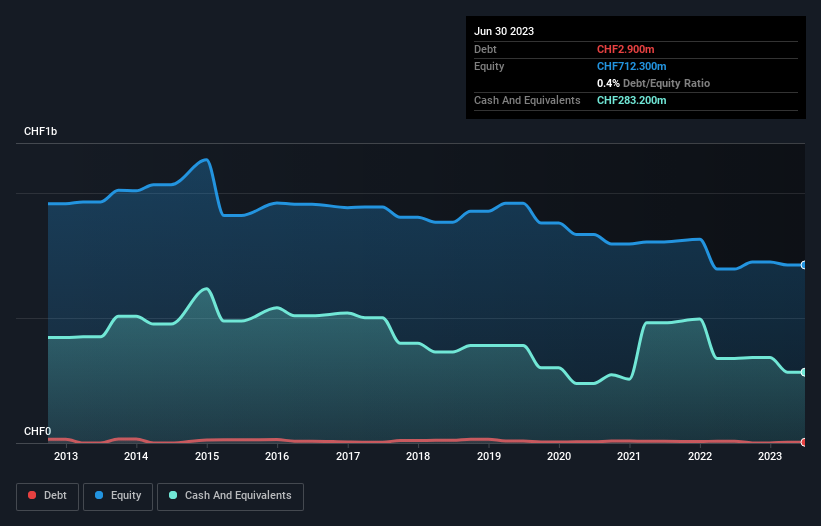
David Iben put it well when he said, 'Volatility is not a risk we care about. What we care about is avoiding the permanent loss of capital.' When we think about how risky a company is, we always like to look at its use of debt, since debt overload can lead to ruin. Importantly, Bystronic AG (VTX:BYS) does carry debt. But should shareholders be worried about its use of debt?
When Is Debt Dangerous?
Debt and other liabilities become risky for a business when it cannot easily fulfill those obligations, either with free cash flow or by raising capital at an attractive price. In the worst case scenario, a company can go bankrupt if it cannot pay its creditors. While that is not too common, we often do see indebted companies permanently diluting shareholders because lenders force them to raise capital at a distressed price. By replacing dilution, though, debt can be an extremely good tool for businesses that need capital to invest in growth at high rates of return. The first thing to do when considering how much debt a business uses is to look at its cash and debt together.
View our latest analysis for Bystronic
What Is Bystronic's Debt?
As you can see below, Bystronic had CHF2.90m of debt at June 2023, down from CHF7.20m a year prior. But it also has CHF283.2m in cash to offset that, meaning it has CHF280.3m net cash.

How Strong Is Bystronic's Balance Sheet?
The latest balance sheet data shows that Bystronic had liabilities of CHF351.3m due within a year, and liabilities of CHF40.2m falling due after that. On the other hand, it had cash of CHF283.2m and CHF211.4m worth of receivables due within a year. So it can boast CHF103.1m more liquid assets than total liabilities.
This surplus suggests that Bystronic has a conservative balance sheet, and could probably eliminate its debt without much difficulty. Succinctly put, Bystronic boasts net cash, so it's fair to say it does not have a heavy debt load!
Better yet, Bystronic grew its EBIT by 204% last year, which is an impressive improvement. That boost will make it even easier to pay down debt going forward. When analysing debt levels, the balance sheet is the obvious place to start. But it is future earnings, more than anything, that will determine Bystronic's ability to maintain a healthy balance sheet going forward. So if you're focused on the future you can check out this free report showing analyst profit forecasts.
Finally, a company can only pay off debt with cold hard cash, not accounting profits. While Bystronic has net cash on its balance sheet, it's still worth taking a look at its ability to convert earnings before interest and tax (EBIT) to free cash flow, to help us understand how quickly it is building (or eroding) that cash balance. In the last three years, Bystronic's free cash flow amounted to 25% of its EBIT, less than we'd expect. That weak cash conversion makes it more difficult to handle indebtedness.
Summing Up
While it is always sensible to investigate a company's debt, in this case Bystronic has CHF280.3m in net cash and a decent-looking balance sheet. And it impressed us with its EBIT growth of 204% over the last year. So is Bystronic's debt a risk? It doesn't seem so to us. When analysing debt levels, the balance sheet is the obvious place to start. But ultimately, every company can contain risks that exist outside of the balance sheet. We've identified 1 warning sign with Bystronic , and understanding them should be part of your investment process.
If, after all that, you're more interested in a fast growing company with a rock-solid balance sheet, then check out our list of net cash growth stocks without delay.
Valuation is complex, but we're here to simplify it.
Discover if Bystronic might be undervalued or overvalued with our detailed analysis, featuring fair value estimates, potential risks, dividends, insider trades, and its financial condition.
Access Free AnalysisHave feedback on this article? Concerned about the content? Get in touch with us directly. Alternatively, email editorial-team (at) simplywallst.com.
This article by Simply Wall St is general in nature. We provide commentary based on historical data and analyst forecasts only using an unbiased methodology and our articles are not intended to be financial advice. It does not constitute a recommendation to buy or sell any stock, and does not take account of your objectives, or your financial situation. We aim to bring you long-term focused analysis driven by fundamental data. Note that our analysis may not factor in the latest price-sensitive company announcements or qualitative material. Simply Wall St has no position in any stocks mentioned.
About SWX:BYS
Bystronic
Through its subsidiaries, engages in the provision of sheet metal processing solutions for cutting, bending, and automation worldwide.
Flawless balance sheet and undervalued.
Market Insights
Community Narratives



